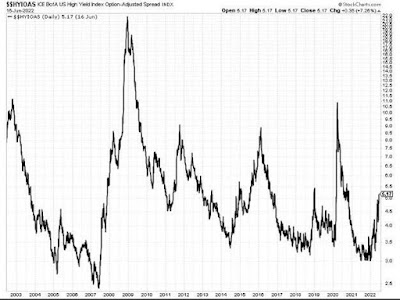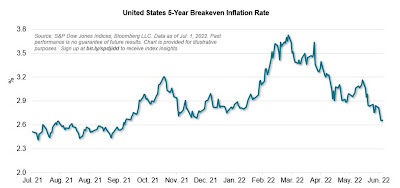*** denotes well-worth reading in full at source (even if excerpted extensively here)
Economic and Market Fare:Malinen: The Economic Growth That Never Was
Steve Keen: Paul Krugman reinvents the wheel
Tweets of the Week:
...Nearly all of the equity drawdown YTD has been multiple based.
— Teddy Vallee (@TeddyVallee) July 4, 2022
Our EPS lead (based on rates, oil, dollar, etc) implies large move lower over following 12 mos.
Next leg lower in equities will clearly be EPS driven, but only after price makes you think we're not in a recession. pic.twitter.com/SCeU8vhuZV
The market is still expensive according to the Buffett Indicator. pic.twitter.com/3th6ICA6AV
— Markets & Mayhem (@Mayhem4Markets) July 4, 2022
Central Banks have extended their monetary policy toolbox with every crisis since 2008.
— jeroen blokland (@jsblokland) July 4, 2022
Every crisis, they pushed #yields down further and created more #liquidity to contain the elephant in the room: #DEBT
What makes you think this time is different?
1:
9:
On the rules of life and Kleiber's law: the macroscopic relationship between materials and energy
Other Fare:
... The excess risk of serious adverse events of special interest surpassed the risk reduction for COVID-19 hospitalization relative to the placebo group in both Pfizer and Moderna trials
Pics of the Week:
24 stunning astronomy photographs that will take you to infinity and beyond
Contrarian Perspectives
Extra [i.e. Controversial] Fare:
*** denotes well-worth reading in full at source (even if excerpted extensively here)
Regular Fare:
Unsustainability Fare:
Figure 2. Energy amounts for 2010 and prior equal to those in Figure 1, with a corresponding amount for 2020. Future energy for 2030, 2040 and 2050 are rough estimates based on the observation that the world is now reaching extraction limits for both coal and oil.
Why hasn’t humanity responded to climate change—currently on track to produce global catastrophe—with the same intensity in which we respond to military threats? And is there a way to reorient the defense sector to enable and support a whole-of-society effort to protect our planet’s ability to support life as we know it?
One barrier is the way we think. Research finds that humanity’s “deep frames”—worldviews wired into our neural circuity over a lifetime, and which influence perception and decision-making at the sub-conscious level—hinder our capacity to understand new kinds of threats. These frames, often reinforced by those they benefit, influence security posture and institutional design.
This helps explain why the climate crisis is generally approached as a scientific, economic, and governance issue. IPCC reports employ social scientists, not security practitioners, to tease out climate-security issues. Legitimate concerns about securitization help ensure that climate response remains a strictly civil matter.
In the security sector itself, thinking about climate change is dominated by Sherri Goodman’s original framing of global warming as a “threat multiplier” introduced in a 2007 CNA report. For example, John Conger, a former Pentagon comptroller who now leads the Center for Climate and Security, writes that global warming is one ingredient of many risk factors; it “amplifies” other threats but is not the threat. Likewise, NATO’s brand-new 2022 Strategic Concept describes climate as both a “challenge” and a “threat multiplier,” last in a list of 14 security concerns.
Consequently, defense forces the world over are ambling toward lower-emission technologies, preparing for more natural disasters, and debating the near-term consequences of a degrading global-security environment. These debates miss the main point: that we are moving toward “a shift to a climate inhospitable for most forms of life” that will bring ecological collapse, violence, hardship, and death on nearly unimaginable scales.
Is there another way? What if the security sector could be persuaded to think of climate change as the central threat? Could it help chart a pathway to a safe planet?
A new approach called PLAN E frames climate and environmental issues not as an influence upon the threat environment, but as the main threat—indeed, a new kind dubbed the hyperthreat—subjected to a military-style analysis and response-planning process. The rationale for this approach and the methods used are outlined in the Spring 2022 issue of the Journal of Advanced Military Studies. To prompt broader imagining of what a new threat posture could look like, Marine Corps University has published a notional PLAN E grand strategy. ....
...This only declines with collapse, any other outcome is just not going to have any impact in the time frames we need. This decade preferably in the next 1-3 years. pic.twitter.com/o4NNLtkrT0
— ArunK (@Resilient_Futur) July 4, 2022
There is no coincidence between thawing Permafrosts the release of Methane, loss of Ice latent Heat and loss of Albedo pic.twitter.com/Phrwu032Lo
— Thomas Reis (@peakaustria) July 3, 2022
Pandemania Fare:
Read everything by eugyppius; el gato malo; Mathew Crawford; Steve Kirsch; Jessica Rose!
Paul Alexander, Berenson, Chudov, Lyons-Weiler, Toby Rogers are also go-to mainstays; a list to which I have added Andreas Oehler, Joey Smalley (aka Metatron) and, Julius Ruechel; Denninger worth staying on top of too for his insights, and especially his colorful language; and Norman Fenton; Marc Girardot; plus Walter Chesnut (on twitter); new additions: Sheldon Yakiwchuk and Aaron Kheriarty; I will of course continue to post links to key Peter McCullough material, and Geert Vanden Bossche, and Robert Malone, and Martin Kulldorff, and Jay Bhattacharya, and Sucharit Bhakdi, and Pierre Kory, and Harvey Risch, and Michael Yeadon, and John Ioannidis, and Paul Marik, and Tess Lawrie, and Zelenko, and Dolores Cahill, and [local prof] Byram Bridle, and Ryan Cole, and…
***** Vanden Bossche: The immuno-epidemiological consequences of the mass vaccination experiment - summary
Charts:
*** check out link for good charts on country-by-country comparisons on various measures, including covid restriction stringency and economic outcomes
...Edward Dowd former Blackrock says the seed of doubt is planted among easily duped corporate CEOs and the tipping point is near where the stronger minds will come out of mass formation first and join the outrage on the needless loss of life. pic.twitter.com/FKhzbjbc6q
— Peter McCullough, MD MPH (@P_McCulloughMD) July 4, 2022
....@provost_patrick, RNA expert, professor and researcher at Université Laval, was recently suspended by the university for eight weeks because of his opinions, which were released last December, on RNA vaccination of children.
— Rebel News (@RebelNewsOnline) July 4, 2022
REPORT by @TheVoiceAlexa: https://t.co/06jobFvtZH pic.twitter.com/zfBTL3p1Ic
Canadian Comedian Nick Nemeroff “Died Suddenly” Aged 32. He Tweeted About Being Vaccinated in February 2021 & Mocked “Anti-Vaxxers” Who Warned Of The Side Effects. pic.twitter.com/Zx2Jzxyouc
— TheNo1Waffler (@TheNo1Waffler) July 6, 2022
Rigger: Sudden Article Derangement Syndrome (SADS)
Back to Non-Pandemic Fare:
Orwellian Fare:
CaitOz Fare:
Other Quotes of the Week:
Astore: Welcome to “extreme life,” as Tom Engelhardt notes today at TomDispatch.com. And while his article focuses mainly on soaring temperatures and extreme weather due to climate change, he starts by noting how the Supreme Court struck down the New York law that restricted the carrying of concealed firearms. Yes, America today is “packing heat” in more ways than one. Rising temperatures, soaring gun sales, more and more mass shootings, increasing alienation and unease: these times aren’t just “interesting,” as the alleged Chinese curse goes, they truly are increasingly extreme
Ilargi: Myocarditis cases in USA, Ages 12-20:
[Not] Satirical Fare:
Dude.pic.twitter.com/2qMQBPOZEB
— Gonzalo Lira (@GonzaloLira1968) July 2, 2022
Tweet Vids of the Week:
...The last 30 seconds of US Empire re-enacted by an American family. #WhoDidThat pic.twitter.com/IS7Hr4ZejV
— Kim Dotcom (@KimDotcom) July 6, 2022
The rebellion started today.. pic.twitter.com/rGhjHoxUcq
— Buitengebieden (@buitengebieden) July 4, 2022
Result of arguing with the ignorant🐊pic.twitter.com/7OLsQMulBN
— nftbadger (@nftbadger) July 3, 2022


















No comments:
Post a Comment